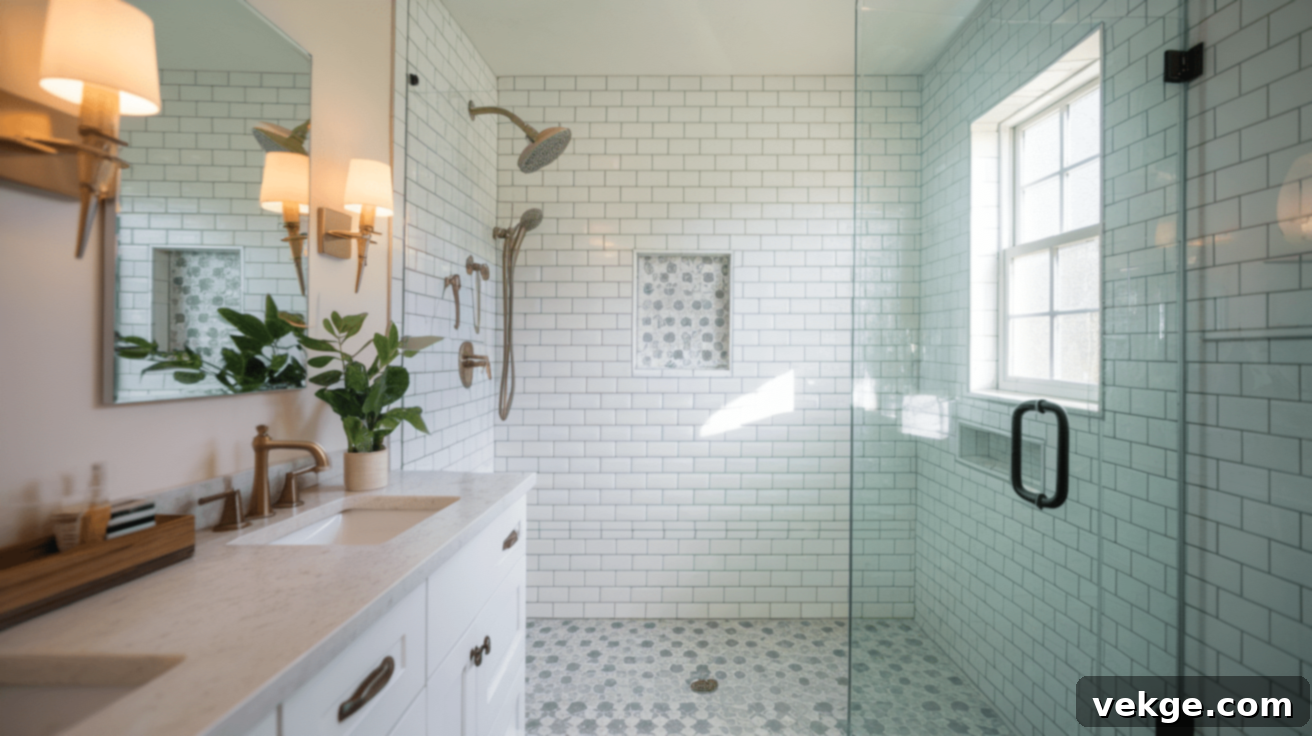Mastering Your Bathroom Shower Remodel: A Complete Guide to Upgrading Your Space
Upgrading your bathroom shower can completely renew your daily routine and transform the entire feel of your home. Whether you’re looking to fix issues with an outdated shower, enhance functionality, or simply refresh your bathroom’s style, a shower remodel offers endless possibilities to achieve your dream space.
This comprehensive guide walks you through every essential phase of the process, from initial planning and budgeting to the intricacies of demolition, installation, and the final aesthetic touches. We’ll delve into critical waterproofing techniques, offer expert material selection tips, and provide practical design ideas that work for various spaces and budgets. Our goal is to empower you with the knowledge to create a shower that perfectly blends function with style.
By following our detailed, step-by-step approach, you’ll be able to navigate the common pitfalls of renovation, ensuring a smooth and successful project. The result? A bathroom that not only meets your practical needs but also adds significant comfort, beauty, and value to your home for years to come.
Your Step-by-Step Guide to a Successful Bathroom Shower Remodel
Remodeling a bathroom shower is a rewarding project that significantly upgrades your space, making it more functional, modern, and enjoyable. A well-executed shower renovation can breathe new life into an old bathroom, improving both its aesthetic appeal and practical utility. Careful planning is the cornerstone of achieving the best results within your budget and vision.
This detailed guide will walk you through each critical step, helping you transform your old, tired shower into a stylish, efficient, and comfortable oasis that perfectly complements your home’s aesthetic and meets your personal needs.
Step 1: Assess and Plan Your Shower Remodel Project

Before you even think about swinging a hammer, dedicating ample time to thorough assessment and meticulous planning will save you considerable money, stress, and potential headaches in the long run. A well-thought-out plan ensures your project stays on budget, adheres to your design vision, and provides a clear roadmap for your entire bathroom update.
Identify Existing Issues and Define the Scope
Begin by carefully examining your current shower space for any warning signs or existing problems. Look for obvious indicators like visible water damage, persistent mold growth, and structural issues, which are particularly common in older bathrooms. Pay special attention to subtle signs of leaks around the shower base, walls, and fixtures. Check for mold spots, especially in corners, along caulking lines, and behind peeling paint. These could indicate hidden moisture problems.
Test if your bathroom fan works correctly and efficiently. Poor or inadequate ventilation is a primary cause of moisture buildup, leading to mold and mildew. Examine the floor and walls for any damage, such as soft spots, warping, or cracks, that might need to be addressed and repaired before any new fixtures or materials can be installed. Understanding these issues upfront will help you define the exact scope of your shower renovation, ensuring you tackle all necessary repairs before building anew.
Set a Realistic Budget
Creating a clear and realistic budget is paramount for a successful shower remodel. Start by making a detailed list of all potential costs, including labor, materials (tiles, fixtures, waterproofing, grout, caulk), and any specialized tools you might need. It’s highly advisable to add a contingency fund, typically 10-15% of your total budget, for unexpected problems like discovering hidden water damage, outdated plumbing, or electrical issues that might only become visible once demolition begins.
Decide whether this is a job you can confidently handle yourself (DIY) or if you need to hire professionals. Keep in mind that critical aspects like plumbing and electrical work often require licensed experts to ensure safety, comply with local building codes, and prevent future problems. Always get multiple quotes from reputable contractors to understand the realistic cost range for your specific project and to compare services before making a decision.
Step 2: Carefully Demolish the Existing Shower Area
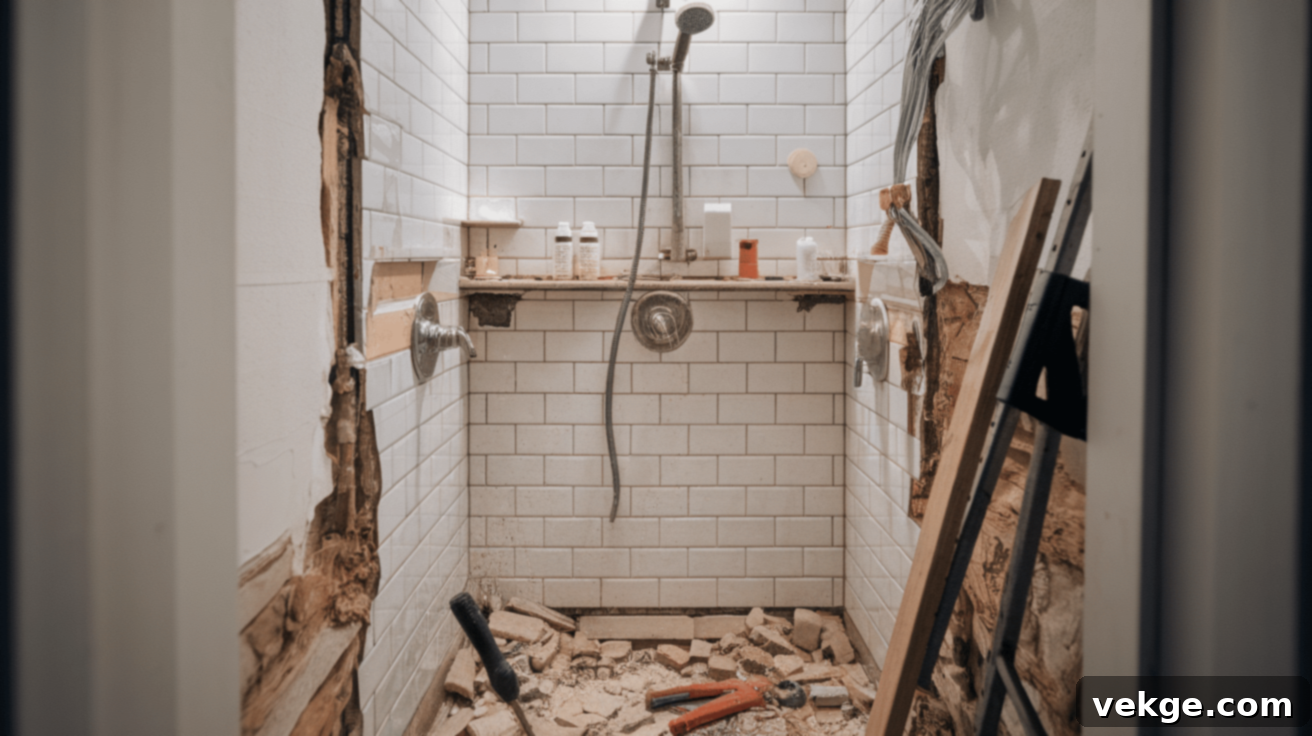
The tear-down phase, while seemingly destructive, requires immense care and a systematic approach to avoid damaging parts of your bathroom that are not being updated. Working methodically will not only make the demolition safer but also significantly ease the subsequent rebuild process.
Before starting any demolition, prioritize safety. Turn off the main water supply to your bathroom to prevent accidental flooding or damage. Next, remove all existing shower components: the showerhead, tub spout, faucet handles, and any shower doors or curtains, saving any items you plan to reuse. Disconnect all plumbing, including drain and water supply lines, keeping a bucket handy to catch any residual water.
Once plumbing is clear, proceed to remove wall coverings such as old tiles, backer board, or wallboard to expose the wall studs and subfloor. You might also find old flooring layers, like vinyl or linoleum, that need to be removed. Use appropriate tools such as pry bars, hammers, and a utility knife, but work carefully to avoid damaging the underlying structural elements like studs or floor joists. As you demolish, thoroughly inspect all newly exposed areas for any signs of water damage, mold, or structural weaknesses. If you uncover any, these sections must be properly treated, repaired, or replaced before you can install new materials, ensuring a solid foundation for your new shower.
Step 3: Assess and Repair the Subfloor and Structure
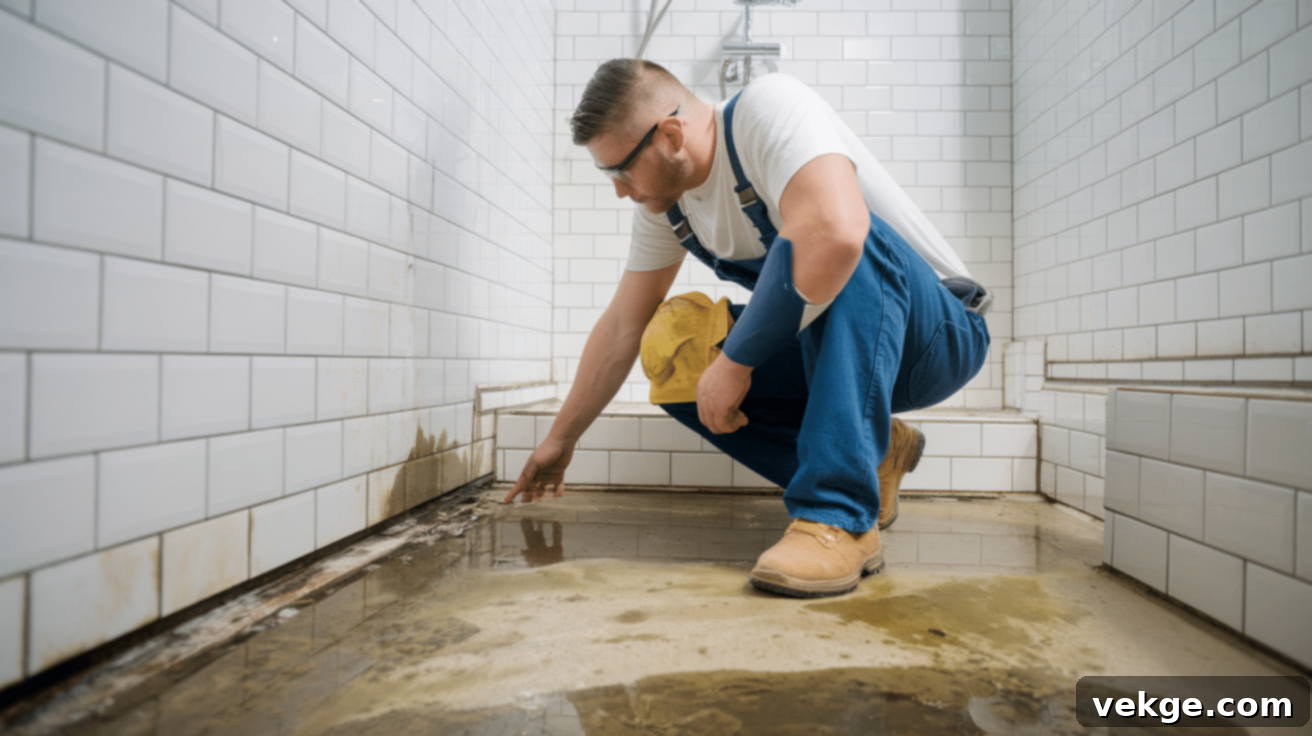
After the demolition, it’s crucial to take your time and thoroughly examine the foundation of your shower area. This critical assessment step helps you identify and rectify any underlying structural or water-related problems before they become costly and inaccessible issues hidden beneath your beautiful new shower.
Check for Water Damage on the Subfloor
Inspect the exposed subfloor for any signs of moisture, dampness, or mold. Water damage often leads to severe structural issues, such as weakened floorboards, rot, or extensive mold growth. Look for discoloration, soft or spongy areas when stepped on, and any musty odors.
If the subfloor feels soft, spongy, or shows signs of rot, it will need to be completely replaced. For minor damage, such as small areas of surface mold or slightly discolored wood, treat and reinforce the area with a mold-resistant primer or sealant after ensuring it’s completely dry. Before proceeding with any new installations, always ensure that both the floor and wall studs are sturdy, level, and sound enough to properly support the weight and integrity of your new shower installation.
Repair or Replace Damaged Subfloor
When planning a shower remodel, a thorough check of your subfloor is absolutely essential. If you notice spots that feel soft or bouncy when you walk on them, or if you see discoloration, warping, or swelling, you very likely have water damage. For small, localized problems, you can often clean the affected area, allow it to dry completely using fans or dehumidifiers, and then apply a high-quality mold-resistant sealant to prevent future issues. However, if the damage covers a large area, if the wood feels significantly weak, or if there’s extensive rot, it is always better and safer to replace the entire damaged section of the subfloor. Taking this proactive step now prevents much bigger and more expensive structural problems later on, ensuring your new shower has a solid and durable base.
Check for Structural Integrity
Before installing your new shower, it’s vital to ensure your bathroom’s underlying structure can adequately support it. Test the floor by walking on it to identify any weak, bouncy, or squeaky spots, which could indicate loose or damaged floor joists. Examine the wall studs where the shower will attach, checking for any cracks, rot, or damage. The entire structure needs to be solid and rigid, as showers are heavy, especially when filled with water and a person. If you discover any structural issues, such as compromised studs or joists, address and fix them promptly by reinforcing or replacing the affected members before moving forward with any new shower construction. This ensures the longevity and safety of your remodeled shower.
Step 4: Install New Plumbing and Ventilation Systems
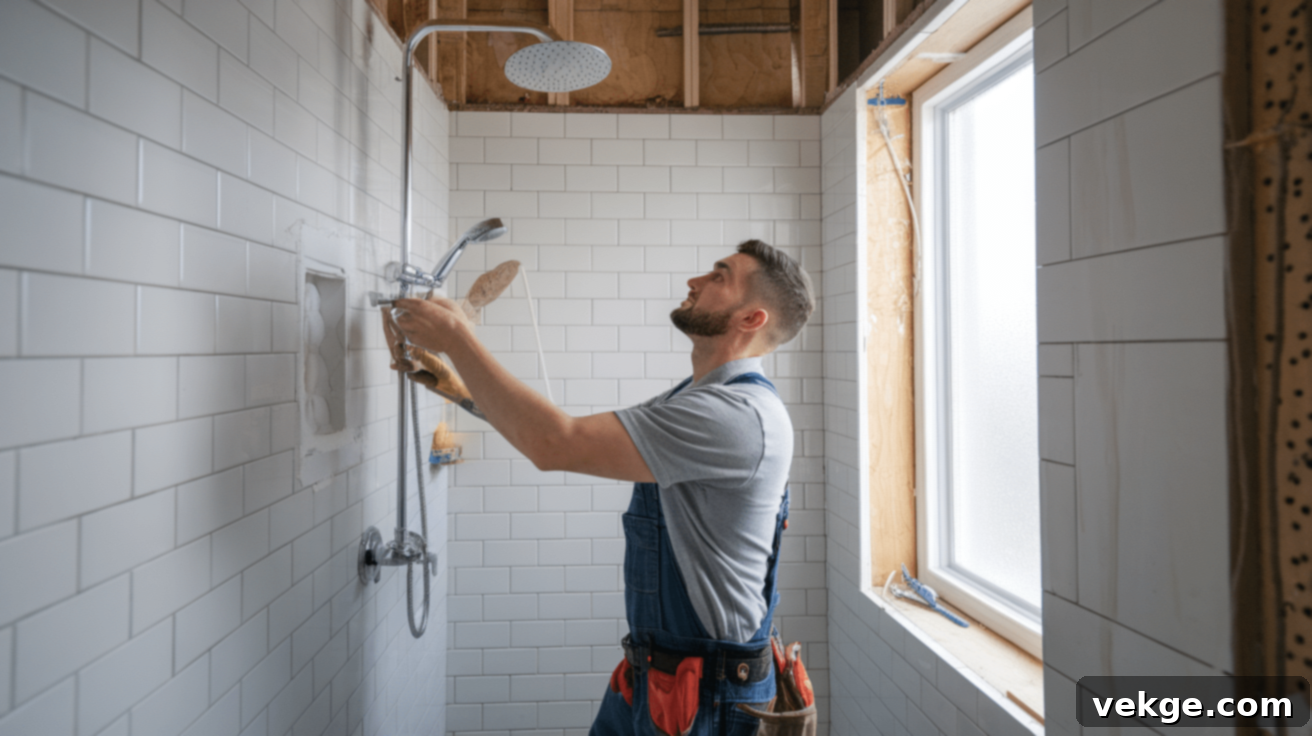
The plumbing and ventilation work forms the hidden backbone of your shower remodel. Getting these crucial elements right during the rough-in phase ensures your new shower will function efficiently, reliably, and safely for many years to come, preventing future headaches and costly repairs.
When updating your shower plumbing, consider modern advancements. A 3-way valve, for instance, allows you to control multiple water sources simultaneously, meaning you can comfortably use your main showerhead and a handheld unit at the same time. For piping, PEX (cross-linked polyethylene) pipes are an excellent option. They are generally more affordable than traditional copper, easier to install due to their flexibility and fewer required joints, and highly resistant to corrosion and freezing. Ensure all connections are secure and tested for leaks before walls are closed up. Also, pay attention to the shower drain installation, ensuring proper slope for efficient water runoff and correct connection to the waste line.
For ventilation, selecting a fan properly sized for your bathroom is critical to prevent moisture buildup. A general rule of thumb is 1 Cubic Foot per Minute (CFM) per square foot of bathroom area, with a minimum of 50 CFM for smaller bathrooms. Crucially, ensure the fan is vented directly outside, not into the attic space, as this can lead to mold and rot. Opt for a quiet model for a more pleasant bathroom experience. Proper ventilation is vital for maintaining air quality and protecting your new shower from moisture-related damage.
Step 5: Install a Robust Waterproofing System
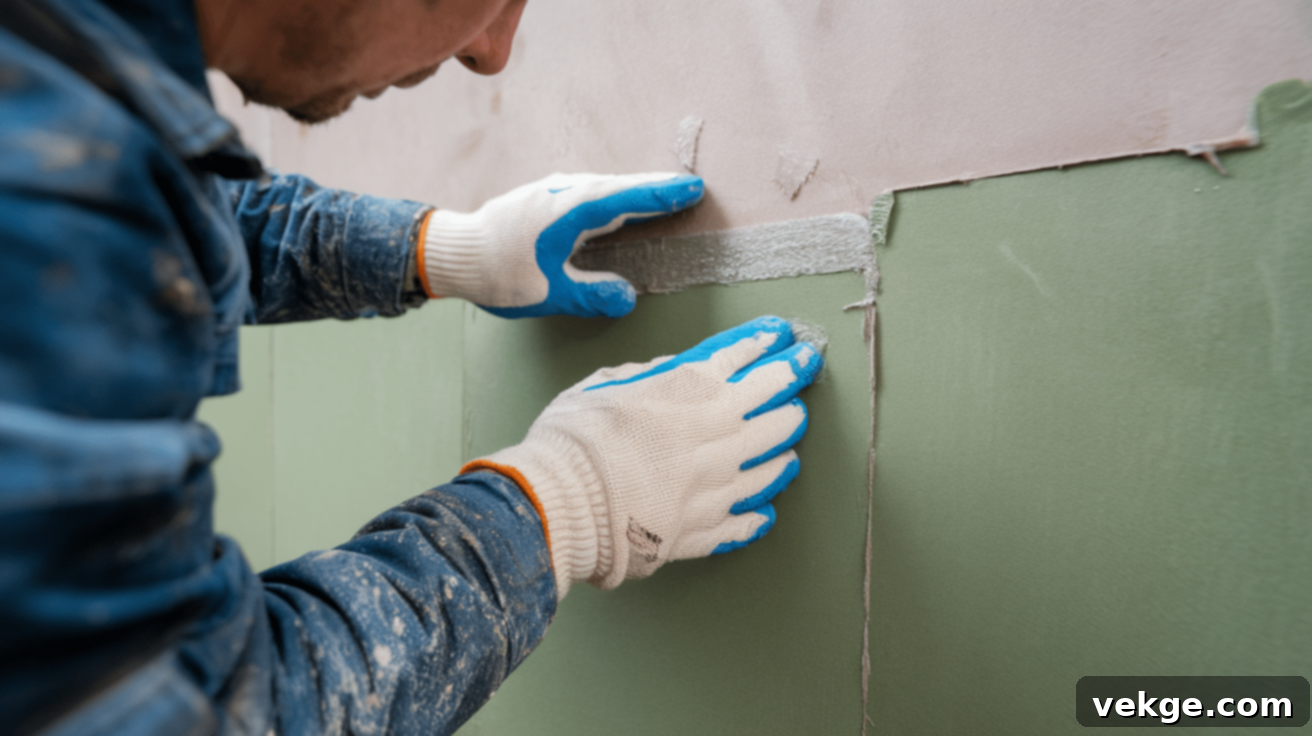
Proper waterproofing is arguably the most critical part of your entire shower remodel. It’s the invisible barrier that protects your home’s structure from costly and potentially destructive water damage. Skimping on this step can lead to devastating consequences down the line.
For shower walls, it is imperative to use water-resistant backer board materials such as cement board or specialized foam-core shower boards, rather than standard drywall. These materials are engineered to withstand prolonged exposure to moisture without breaking down, swelling, or promoting mold growth. Once the backer boards are securely installed, apply a high-quality waterproofing membrane. This can be a liquid-applied product like RedGard or AquaDefense, which creates a continuous, seamless barrier, or a sheet membrane system such as Schluter-Kerdi, which is applied directly over the backer board. This extra layer of protection forms a complete seal, preventing any water from reaching the wooden studs and structural elements behind your shower walls.
Every seam, corner, and penetration point in your shower needs meticulous sealing. Use a high-quality silicone sealant or specialized waterproofing caulk around all joints, especially where the shower walls meet the floor, where walls meet each other, and around the shower curb. Pay particular attention to spots where plumbing fixtures (showerhead, faucet, valve) penetrate the wall. These areas are vulnerable to leaks and must be thoroughly sealed to prevent water intrusion into hidden spaces where it can cause significant damage. Taking your time with this step, ensuring every potential weak point is addressed, will provide long-term peace of mind and protect your investment.
Step 6: Install Your New Shower Walls

Installing your new shower walls is a key step that profoundly defines both the visual appeal and the long-term durability of your remodeled shower. The materials and installation methods you choose and execute here will directly impact how your shower performs for years to come, as well as the amount of maintenance it will require.
When selecting your wall material, tile is an overwhelmingly popular choice, offering a vast array of benefits. Tile comes in various options such as ceramic, porcelain, and natural stone, catering to different budgets, design aesthetics, and durability needs. Porcelain tiles are particularly favored for showers due to their extremely low water absorption, making them highly durable and resistant to moisture. Large-format tiles or classic subway tiles are excellent choices as they reduce the number of grout lines, which means less cleaning and maintenance over time.
For the tiling process, precision is key:
- Begin by creating a level ledger board or using a laser level to ensure your first row of tiles is perfectly straight, as this sets the standard for the entire wall.
- Start tiling from the bottom upwards, working in manageable sections.
- Apply thin-set adhesive carefully and evenly to the back of each tile (back-buttering) and to the wall using a notched trowel, ensuring full coverage to prevent voids.
- Press each tile firmly into place, using tile spacers to maintain consistent grout lines.
- Regularly check for level and plumb with a level. Allow proper drying time for the thin-set to cure before grouting.
When grouting, push the material firmly and completely into all joints using a rubber float, working in small sections. Clean excess grout promptly from the tile surface with a damp sponge before it begins to set and harden. This helps create smooth, even, and professional-looking grout lines. Finally, allow the grout to cure fully according to the manufacturer’s instructions, typically 24-72 hours, before using the shower. Once cured, apply a high-quality grout sealer to protect against stains and moisture penetration, especially for porous grout types.
Step 7: Install the Shower Base or Floor
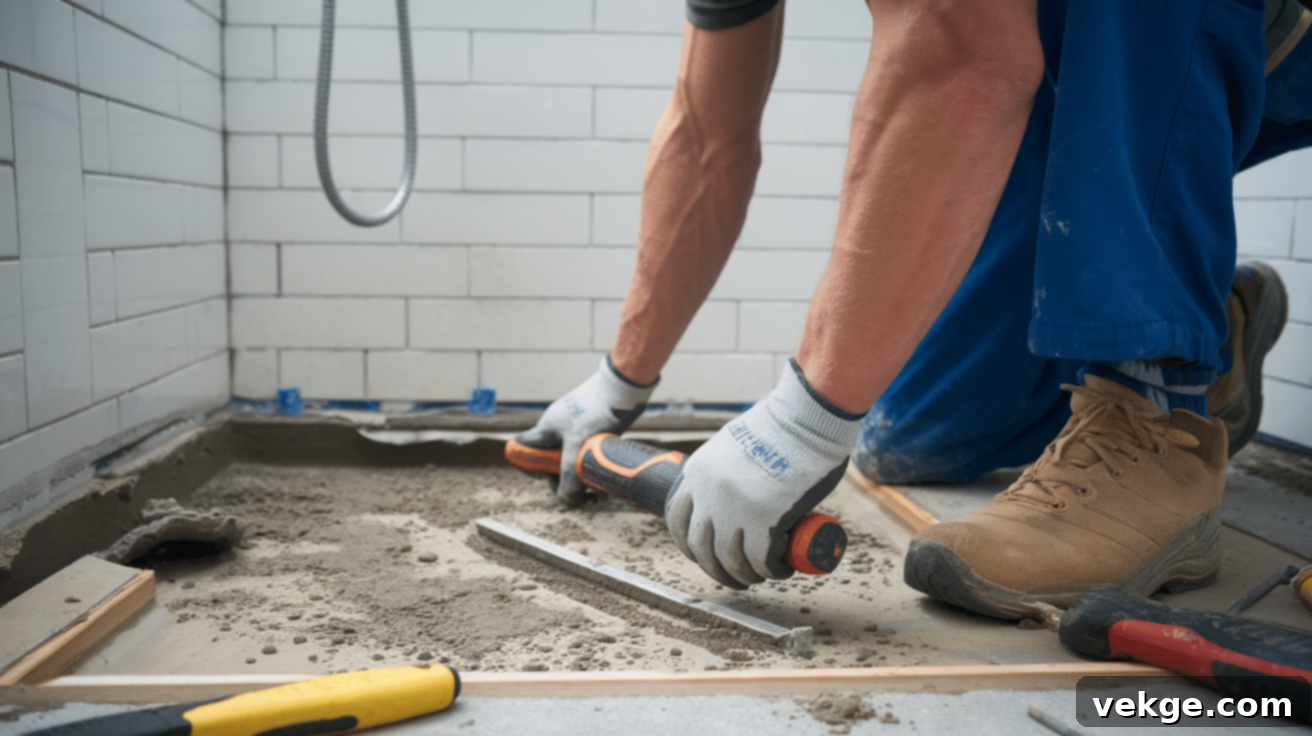
The shower base or floor is the fundamental foundation of your shower, dictating both efficient drainage and user comfort. You have two primary options: a pre-formed shower base for easier installation or building a custom shower pan, which offers greater design freedom for unique shapes, sizes, and accessibility needs.
Pre-formed bases, often made from acrylic, fiberglass, or composite materials, come ready to install and typically simplify the waterproofing process for the floor. Custom pans, on the other hand, require more skill, involving building a sloped mortar bed over a waterproof membrane (like a PVC liner or liquid-applied membrane) to ensure proper drainage toward the drain. While more labor-intensive, custom pans allow for any tile choice and can create curbless entry showers for enhanced accessibility.
Regardless of your choice, preparation and precision are absolutely essential during the floor installation process. The subfloor beneath the base or custom pan must be completely level and structurally sound. If tiling a custom pan, the floor must be perfectly sloped towards the drain to ensure proper water runoff and prevent pooling. A minimum slope of ¼ inch per foot is generally recommended.
- If installing a prefabricated base, follow manufacturer instructions for proper leveling and securing. Seal the perimeter thoroughly.
- If tiling a custom pan, apply thin-set mortar evenly across the sloped shower floor using the appropriate notched trowel.
- Place tiles carefully, starting from the drain outwards, constantly checking alignment and slope as you go.
- Use spacers to maintain consistent grout lines between tiles.
- Allow adequate drying time (typically 24 hours) before walking on or grouting the new surface.
- Apply grout with a rubber float, firmly working it into all joints to ensure full coverage.
- Clean excess grout from the tile surface promptly before it hardens completely, using a damp sponge.
- Once cured, apply a grout sealer to protect the floor.
Step 8: Install Shower Fixtures and Accessories
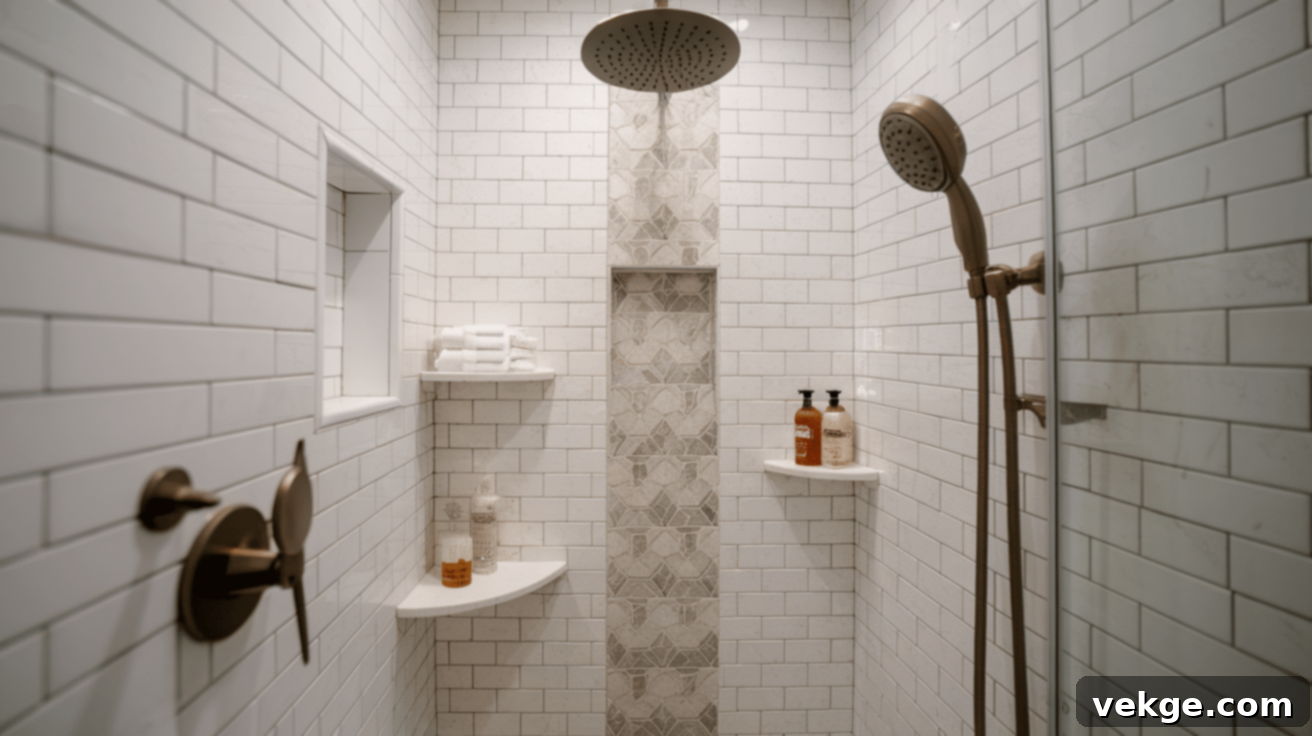
The final touches of your shower remodel involve adding the fixtures and accessories that make the space both highly functional and personally tailored to your preferences. This exciting step truly transforms your shower from a construction project into a finished, inviting, and personalized bathroom feature.
Install Showerhead and Faucet Trim
When installing the showerhead, faucet, and control trim, carefully select fixtures that not only match your desired style but also meet your water pressure and flow needs. Ensure you use the correct connectors and adaptors for your specific plumbing system (PEX, copper, etc.) and tighten all fittings properly to prevent any potential water leaks. Even small, undetected drips can cause significant damage and mold growth over time, so pay meticulous attention to each connection, using plumber’s tape or pipe compound as recommended. Test the plumbing for leaks before fully sealing the wall plates.
Add Accessories for Functionality and Style
For accessories, think about what would make your daily showering routine more convenient and enjoyable. Built-in shower shelves or a custom niche provide elegant and practical spots for storing bath products, keeping the area organized and clutter-free. A sturdy shower bench, whether built-in or freestanding, can add comfort, especially for shaving legs, and significantly improve accessibility for individuals with mobility challenges. Consider adding grab bars for safety, particularly in a family or elder-friendly bathroom.
When choosing between a shower door or a curtain, consider both your space and style preferences. Many homeowners now favor frameless or semi-frameless glass doors for their clean, modern look that makes the bathroom appear larger and brighter by allowing light to flow freely. While glass doors may be a higher initial investment and require more cleaning to prevent water spots, they offer a sophisticated aesthetic. Shower curtains, on the other hand, offer more color and pattern options, are typically more budget-friendly, and are easier to replace or change to update the bathroom’s look seasonally.
Step 9: Finish the Room with Caulk and Paint
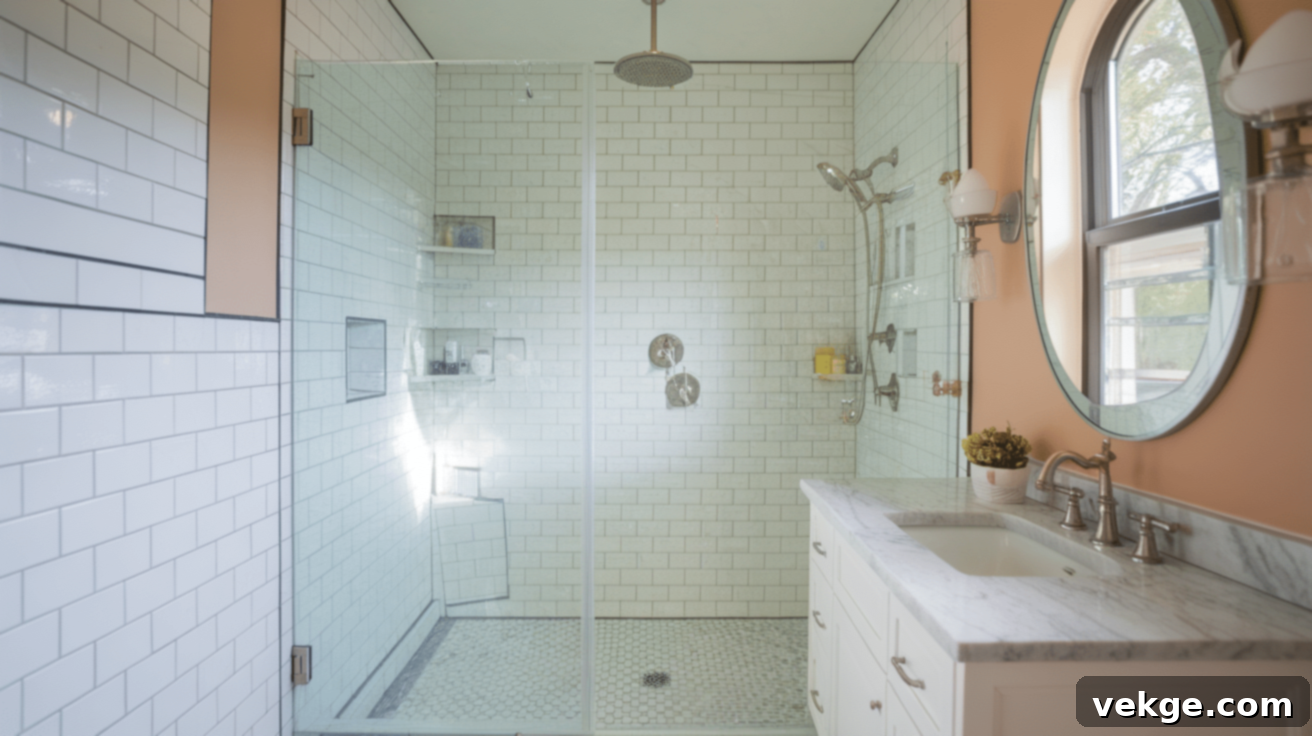
Completing your shower remodel requires careful attention to sealing and final aesthetic details to ensure both lasting beauty and flawless function. These last steps are crucial for protecting your investment, preventing moisture damage, and creating a clean, professional, and finished look for your entire bathroom.
Apply high-quality, waterproof caulk around all edges of your shower walls, paying close attention to points where tiles meet the shower base or tub, and where walls meet other bathroom surfaces. This creates a critical watertight seal that prevents moisture from penetrating behind your tiles and causing damage to the substrate. Choose a caulk that matches your grout color for a seamless, integrated appearance, or a clear caulk for a subtle finish. Ensure you apply the caulk smoothly and consistently, tooling the bead for a professional look.
For final touches, install any necessary trim pieces, such as baseboards or quarter-round, that frame your shower area or other parts of the bathroom. Touch-up paint on walls or ceilings that may have been affected by the construction process, using a moisture-resistant bathroom paint for durability. Finally, give the entire bathroom a thorough cleaning to remove all construction dust, debris, and grout haze. Wipe down all surfaces, fixtures, and glass doors to reveal the true beauty and sparkling finish of your newly remodeled shower space, ready for its grand debut.
Step 10: Test and Inspect Your New Shower
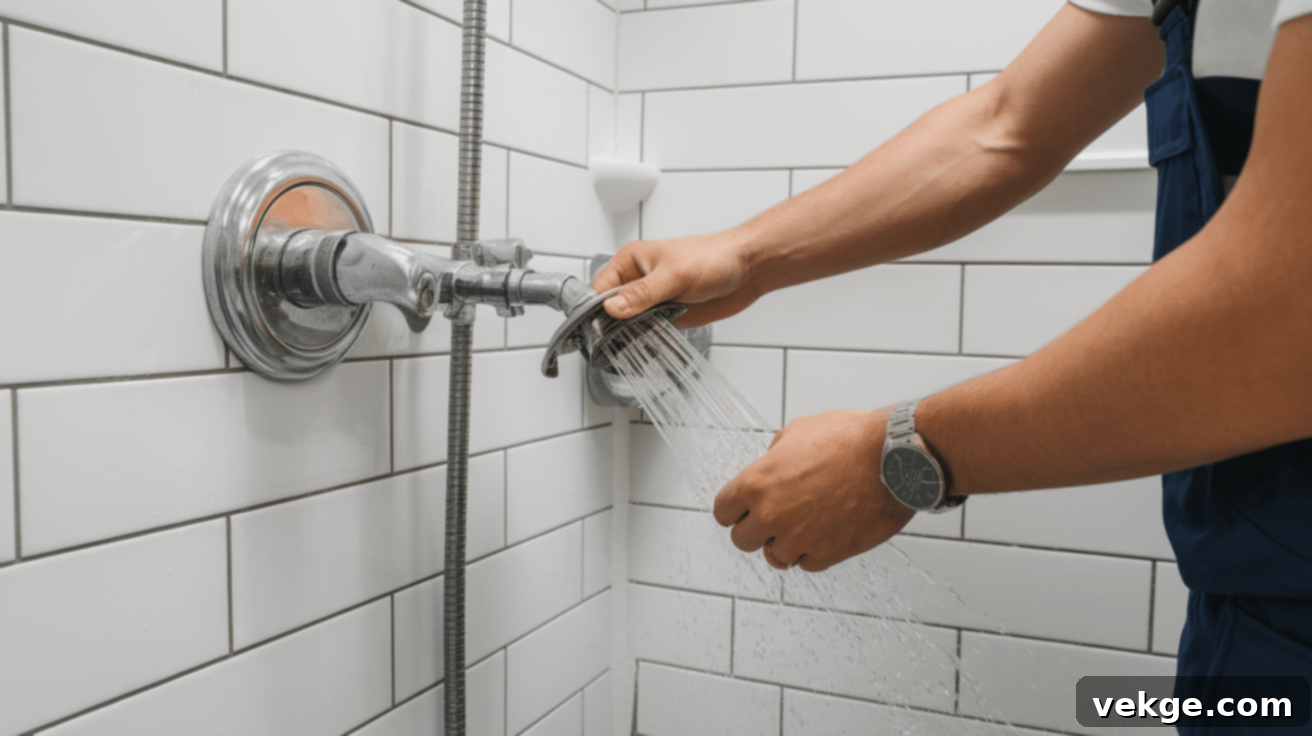
The final and perhaps most satisfying phase of your shower remodel involves a thorough testing and inspection process to ensure everything works correctly and efficiently before daily use. This critical step helps catch any small issues or potential problems before they escalate into major, costly repairs down the road.
Begin by slowly turning on the water supply to the shower. Systematically check for leaks around all fixtures, paying extremely close attention to the faucet, showerhead, and all connections at the shower base and where the drain meets the floor. Use a dry tissue or paper towel to gently wipe around each connection; any dampness indicates a leak that needs immediate attention. If you notice any dripping, tighten connections carefully or apply additional sealant as necessary. Even tiny, seemingly insignificant leaks can cause significant, hidden water damage over time, so be diligent in your inspection.
Complete a final inspection by meticulously checking that all tile surfaces are level, properly set, and securely adhered. Examine grout lines to ensure they are even, fully cured, and free from cracks or voids. If you installed a shower door, test that it opens and closes smoothly, latches correctly, and forms a watertight seal. Walk on the shower floor to verify that it feels solid and stable, without any movement or squeaking. Check the functionality of the ventilation fan and ensure adequate airflow. Once you are completely satisfied with every aspect of your new shower’s performance and appearance, give the entire area a final, detailed cleaning to remove any lingering construction dust, fingerprints, or debris. Your beautifully remodeled shower is now ready to enjoy!
Inspiring Shower Ideas to Upgrade or Remodel Your Bathroom
Updating your shower can completely change how your bathroom looks, feels, and functions. Whether you’re planning a quick refresh or a complete overhaul, these inspiring ideas offer stylish and practical options for almost any budget and aesthetic preference. The right shower design can transform your daily routine into a luxurious experience while significantly adding value and appeal to your home.
1. Walk-In Showers
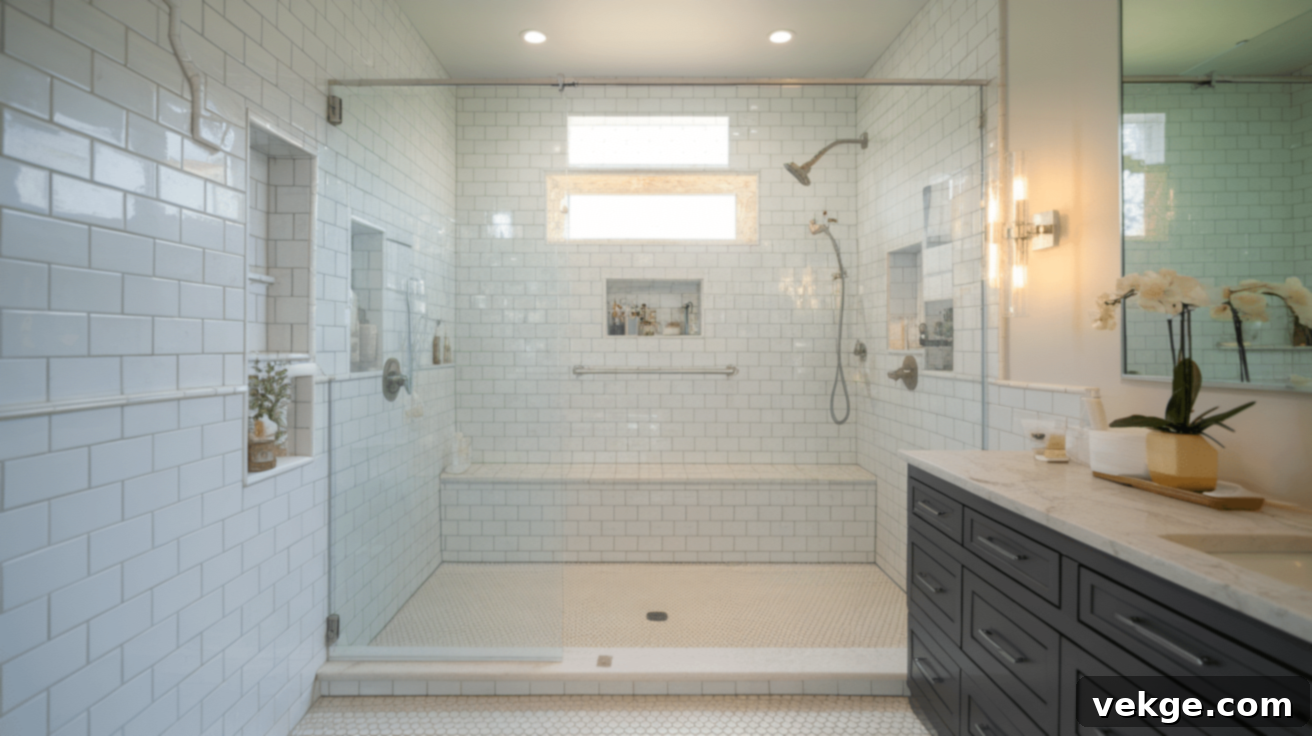
Walk-in showers are a hallmark of modern bathroom design, creating an open, airy, and exceptionally spacious feel in any bathroom. By removing traditional barriers like curbs or doors, these designs make the entire space feel larger, more accessible, and seamlessly integrated. They are particularly well-suited for individuals with mobility concerns, offering a barrier-free entry. Aesthetically, walk-in showers add a sleek, clean, and contemporary look to your bathroom, often becoming a stunning focal point. You can customize them with luxurious tile work, built-in benches, and multiple showerheads for a true spa-like experience.
2. Frameless Glass Shower Doors
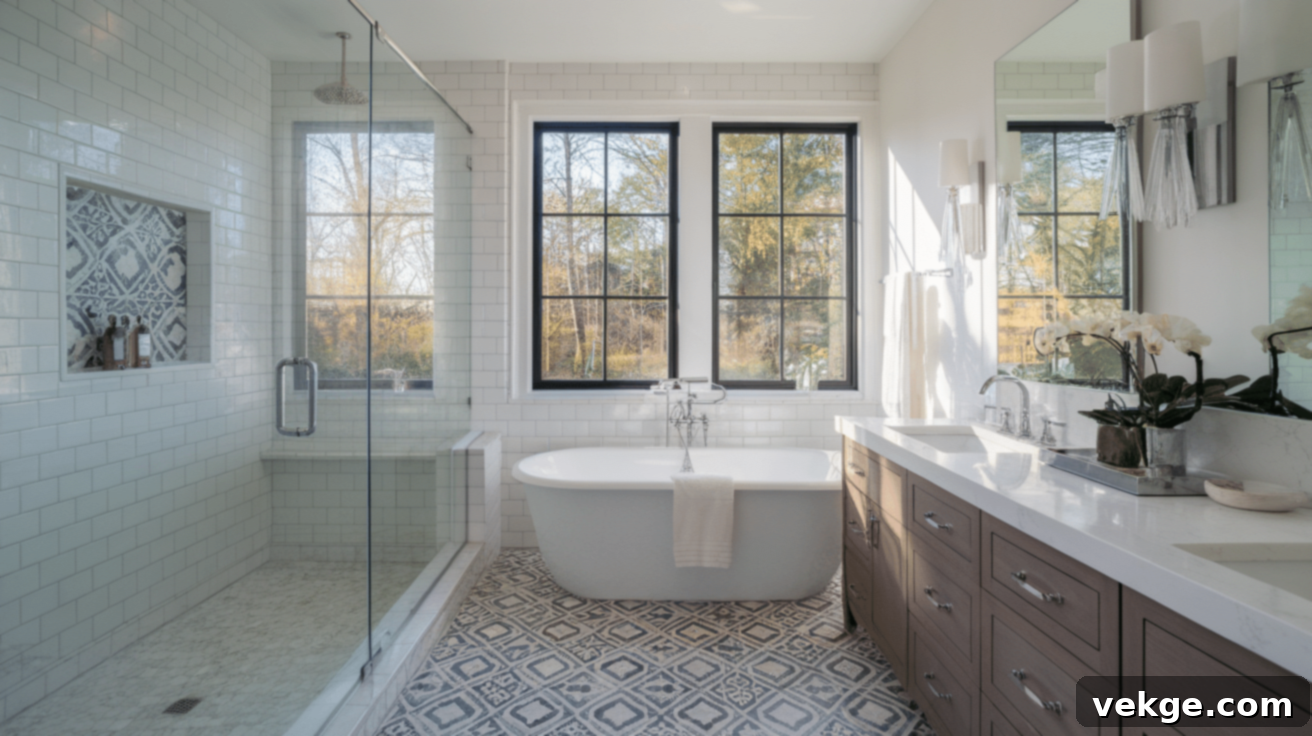
Frameless glass shower doors are a popular choice for achieving a high-end, contemporary look. Their smooth, unbroken lines create a visually expansive effect that makes your bathroom seem bigger, brighter, and more open. The clear glass beautifully showcases intricate tile work, unique wall textures, and allows natural or artificial light to flow freely throughout the space. This is particularly beneficial for smaller bathrooms, where frameless doors can make the area feel significantly less cramped and more luxurious. While they may require more frequent cleaning to maintain their pristine appearance, the aesthetic impact is undeniable.
3. Tub-to-Shower Conversion
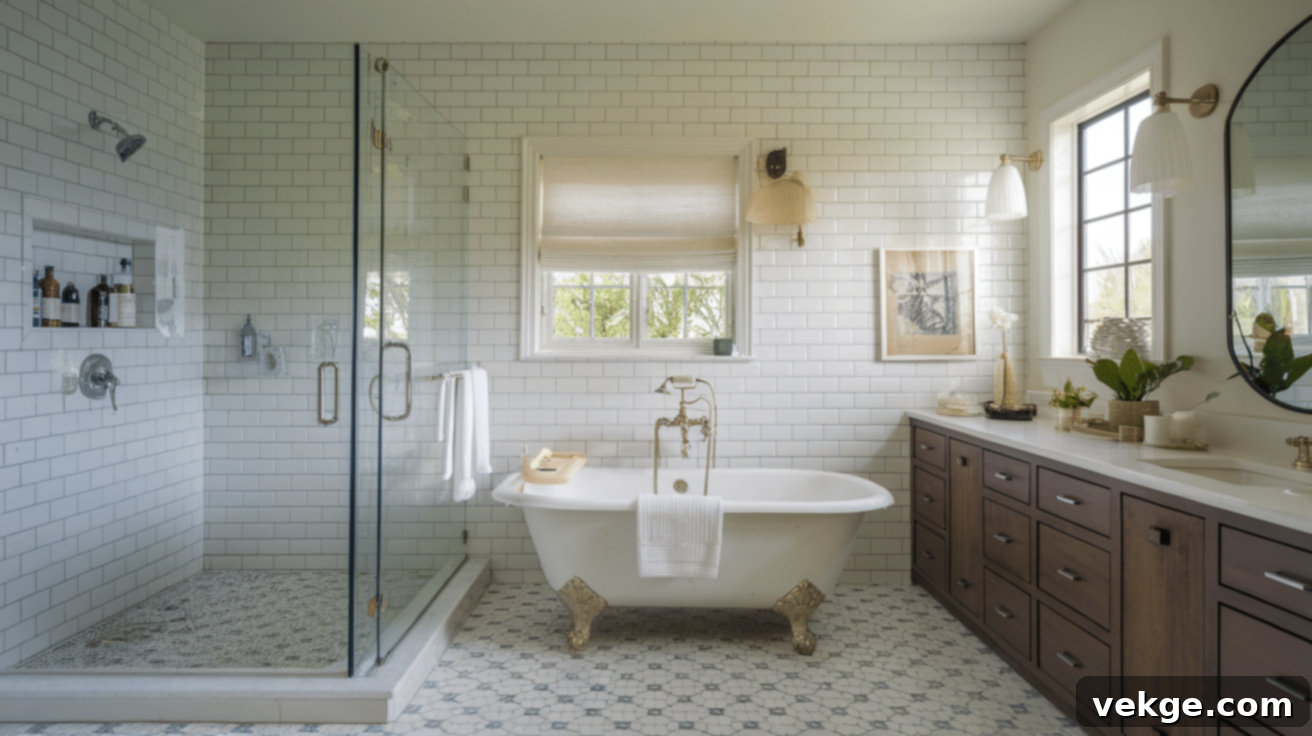
Converting an underused or old bathtub into a dedicated shower enclosure is an increasingly popular renovation. This transformation significantly increases the usable space and overall functionality of your bathroom, making it feel more modern and open. This change works exceptionally well for homeowners who rarely use a bathtub and instead prefer the quick convenience, efficiency, and accessibility of a shower. A tub-to-shower conversion can also enhance safety by eliminating the high step-over of a tub and can be designed with a low-curb or curbless entry, further improving accessibility and giving the room a more contemporary, streamlined feel.
4. Rain Showerheads

Rain showerheads are designed to create a gentle, immersive, and full-body water flow that mimics the soothing sensation of standing in natural rainfall. These luxurious fixtures typically mount directly overhead, providing wide and even water coverage that feels incredibly relaxing and indulgent. Installing a rain showerhead instantly elevates your daily shower into a mini spa treatment, offering a tranquil escape. They are often combined with standard showerheads or handheld sprays for added versatility, allowing you to choose your preferred showering experience based on your mood.
5. Dual Showerheads
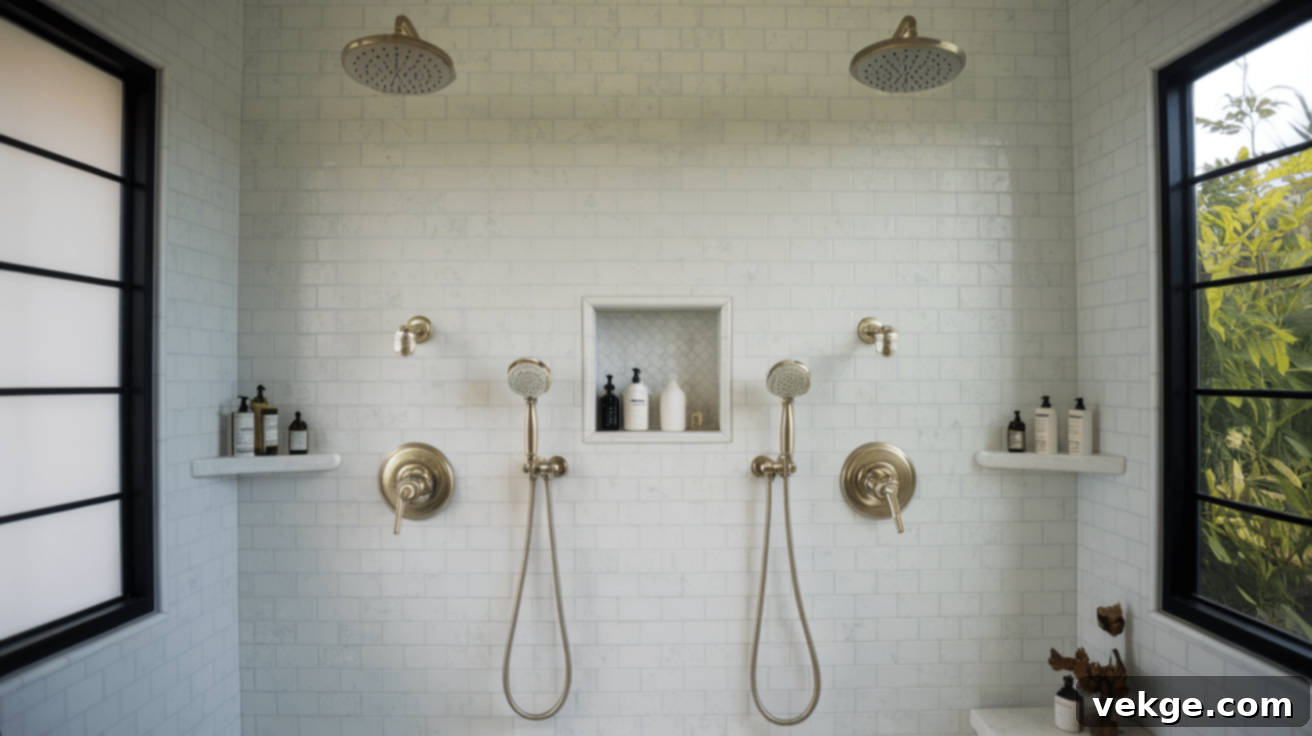
Dual showerheads offer the best of both worlds, integrating both a fixed overhead showerhead and a versatile handheld unit within a single shower enclosure. This setup provides ultimate flexibility and convenience. You can effortlessly switch between a steady overhead stream for a refreshing rinse and a movable spray for targeted washing, making tasks like washing hair, cleaning the shower, or bathing pets much easier. Dual showerhead systems are also perfect for couples, allowing two people to shower comfortably at the same time, or for creating a more comprehensive, multi-sensory showering experience with body sprays.
6. High-Tech Shower Systems
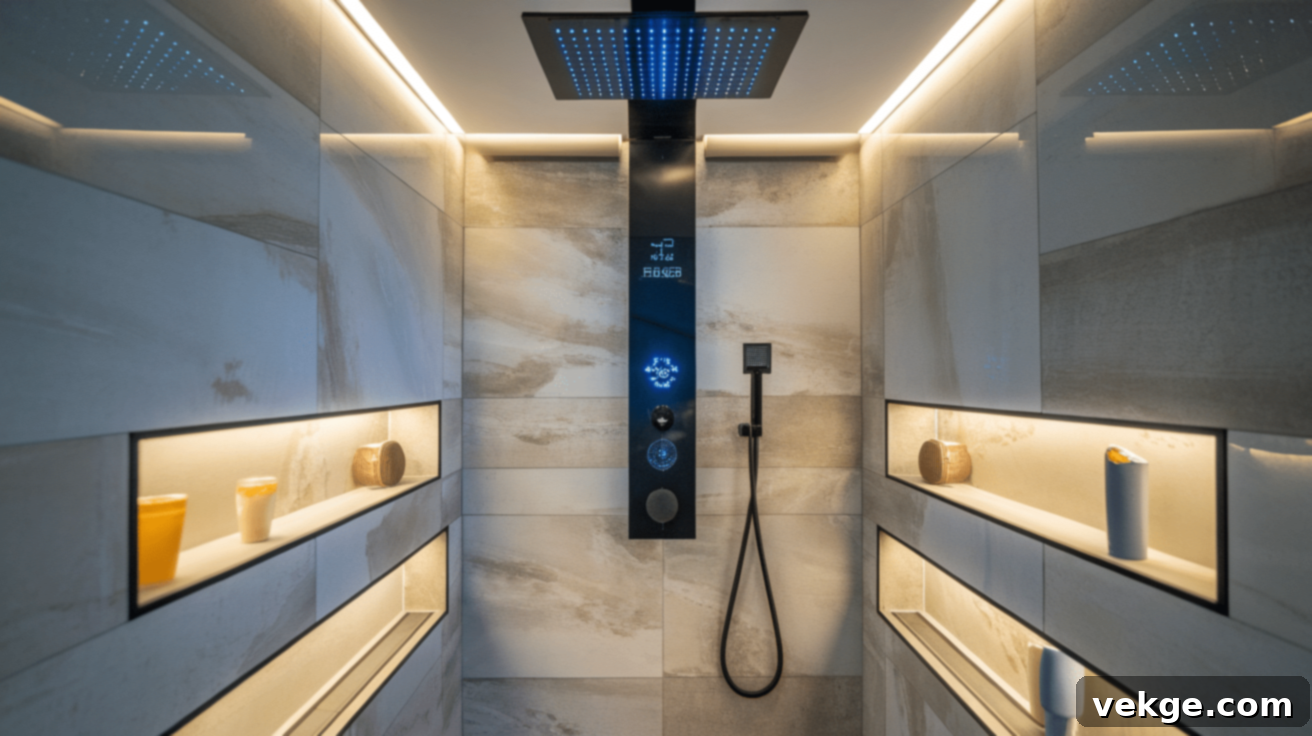
Embrace the future of bathing with high-tech shower systems that offer an array of smart features. These advanced setups include digital controls for precise water temperature and pressure, ensuring a perfect shower every time. Many integrate built-in Bluetooth speakers for music or podcasts, transforming your shower into a personal concert hall. Some systems even incorporate water-saving features, reducing consumption without compromising performance. Additional innovations include LED lights that can change color based on water temperature (a safety feature and mood enhancer) and steam functions for a true home spa experience. While a higher investment, high-tech showers offer unparalleled personalization and convenience.
7. Subway Tile Showers
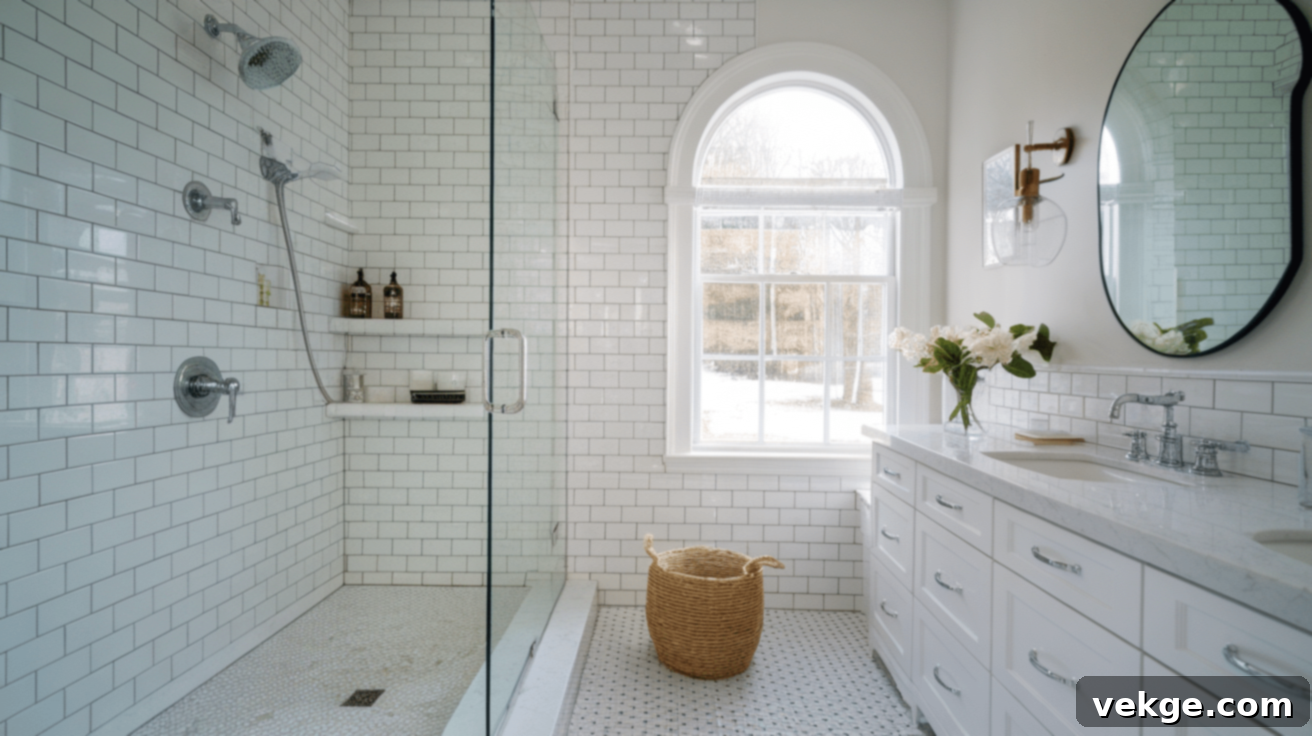
Subway tiles offer a clean, classic, and incredibly versatile look that fits almost any bathroom style, from traditional to ultra-modern. Their simple rectangular shape, typically 3×6 inches, can be arranged in various patterns (offset, herringbone, vertical stack) to create visual interest while remaining subtle enough to complement diverse design choices. Available in a wide range of colors, finishes (glossy, matte), and materials (ceramic, porcelain, glass), subway tiles are both cost-effective and timeless. They provide a backdrop that can be easily updated with different fixtures and accessories, ensuring your shower remains stylish for years.
8. Mosaic Tile Patterns
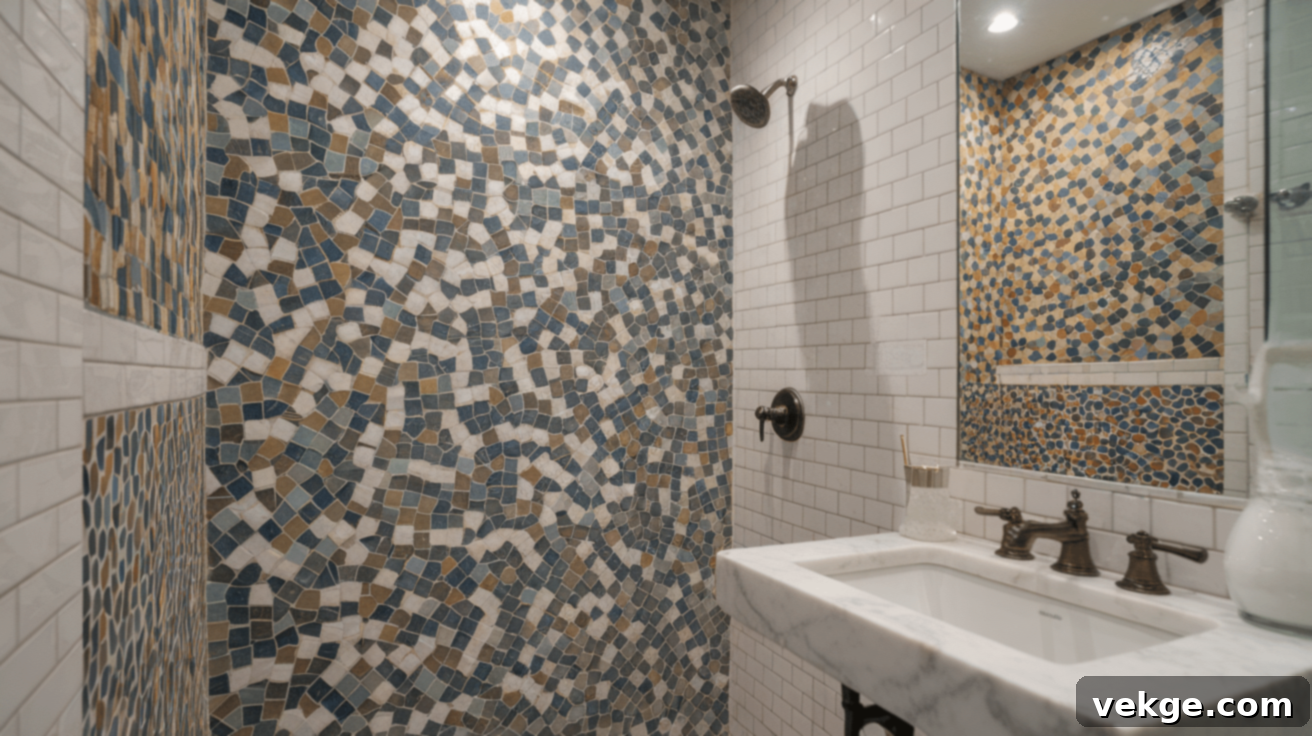
Mosaic tiles are an excellent way to inject vibrant color, intricate patterns, and unique personality into your shower. Composed of many small tiles, often mounted on mesh sheets for easier installation, mosaics allow for countless design combinations. They can be used to create stunning accent walls, decorative borders, or even custom pictorial designs that make your shower truly one-of-a-kind. Mosaic tiles add visual texture and depth, transforming a basic shower wall into a beautiful focal point for the entire bathroom. They are particularly effective in niches or on the shower floor where their smaller size offers better grip and flexibility for sloping.
9. Natural Stone Tile Showers
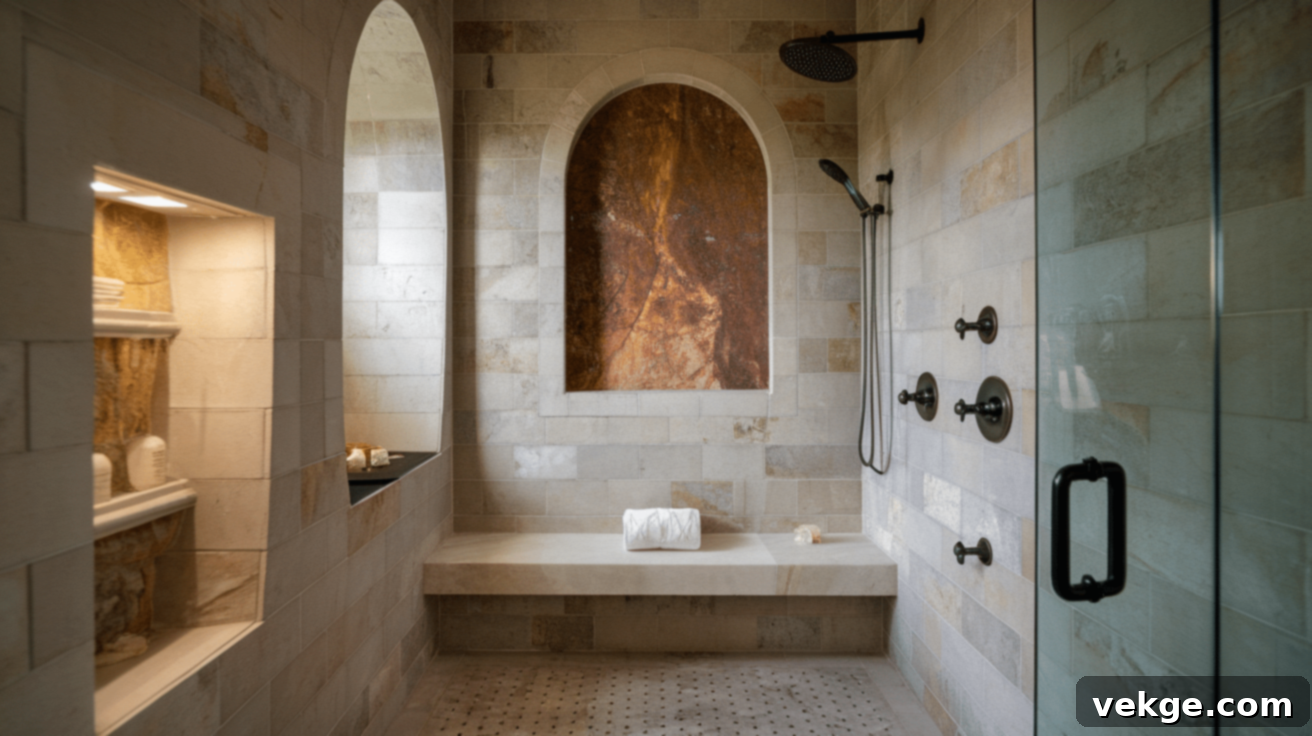
Natural stone brings the timeless beauty and unique character of the outdoors directly inside your bathroom. Each stone tile, whether marble, granite, travertine, or slate, boasts distinct patterns, veining, and colors, creating a one-of-a-kind shower space. Materials like marble offer unparalleled elegance, while slate provides a rustic, earthy feel. Natural stone adds rich texture, visual depth, and an undeniable sense of luxury and lasting quality to your bathroom. However, it’s important to note that natural stone typically requires regular sealing to protect against water absorption and staining, and some types can be more porous, demanding careful maintenance.
10. Shiplap Wall Showers (with Proper Waterproofing)
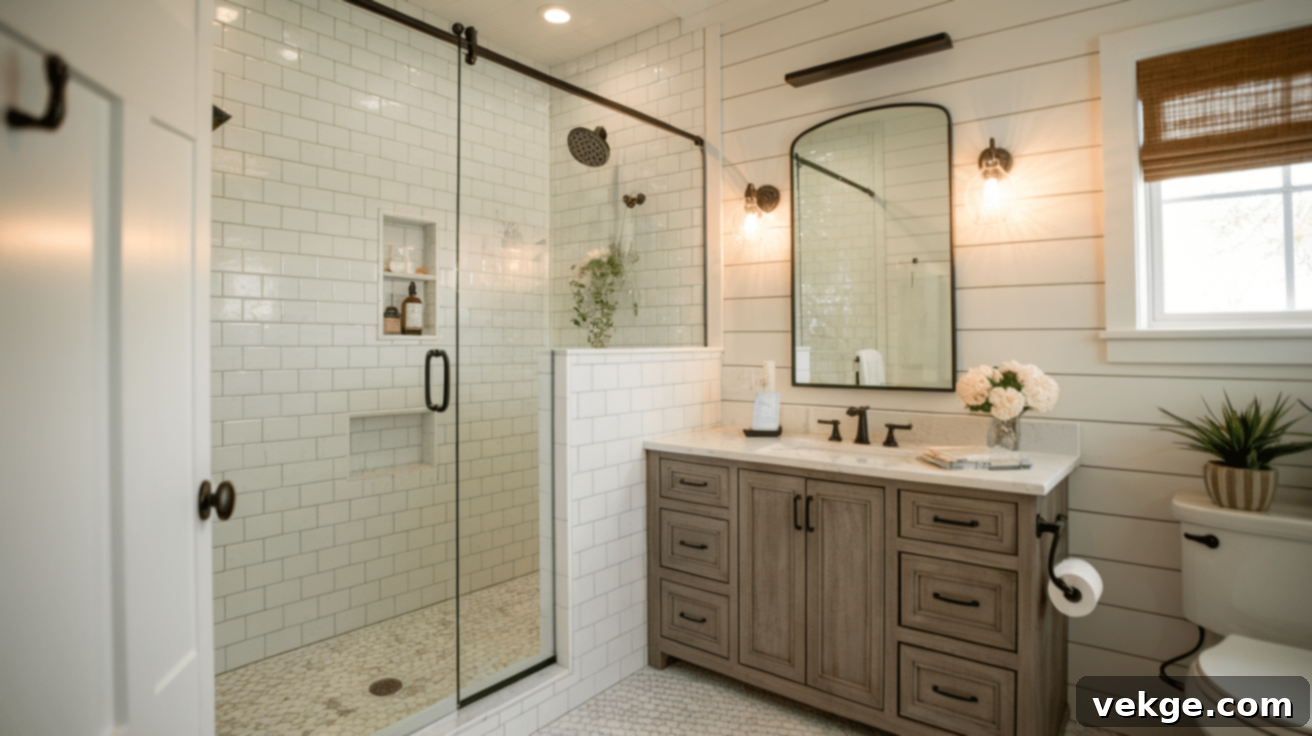
Shiplap walls can bring a touch of warmth, character, and a popular farmhouse or coastal aesthetic to shower spaces. The distinct horizontal lines of shiplap create a sense of width, which can be particularly beneficial in smaller bathrooms. While traditional wood shiplap is not suitable for wet areas without extensive protection, modern, moisture-resistant alternatives (like PVC or composite shiplap panels, or properly sealed and waterproofed cement board shiplap) can be used. This look pairs beautifully with both modern black fixtures for a current, industrial feel or vintage elements for a more rustic, country-inspired design. Proper waterproofing behind the shiplap is absolutely crucial to prevent moisture damage.
11. Bold Color Tiles

For those looking to make a statement, colorful tiles can instantly turn your shower into the star of your bathroom. Deep blues, rich greens, warm terracottas, or even vibrant yellows and reds can create a unique mood and inject personality into an otherwise plain space. Bold colors can evoke feelings of calm, energy, or luxury, depending on the shade. Even using a splash of color on just one accent wall or in a niche can completely change how your shower looks and feels, transforming it into an artistic centerpiece. Don’t shy away from expressing your style with a daring palette.
Conclusion: Your Dream Shower Awaits
Remodeling your shower offers a wealth of opportunities to significantly improve both the function and the aesthetic appeal of your bathroom. From relatively simple updates like replacing outdated fixtures to complete overhauls involving custom tile work and structural changes, the options are plentiful and can be tailored to various budgets, skill levels, and personal tastes.
As you plan your project, carefully consider what matters most to you. Is it gaining extra space with a walk-in design? Enhancing accessibility for future needs? Prioritizing water savings with efficient fixtures? Or simply achieving a more modern, spa-like style? Your vision should guide every decision.
Take the necessary time to thoroughly assess your current needs, establish a clear and realistic budget, and meticulously plan each step of the renovation process. By investing in proper preparation, selecting high-quality materials, and executing each phase with care, you’ll avoid common pitfalls and ensure a lasting, beautiful result. With thoughtful planning and the right approach, your shower update can truly transform your daily routine, becoming a source of comfort and luxury, while simultaneously adding lasting value and undeniable appeal to your home.
